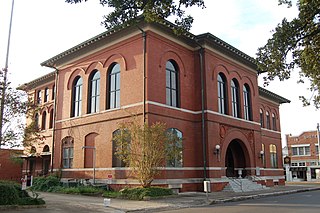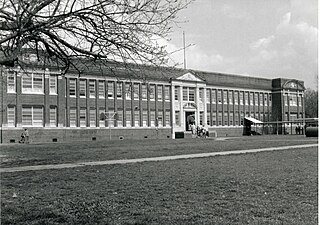
St. Landry Parish is a parish located in the U.S. state of Louisiana. As of the 2020 Census, the population was 82,540. The parish seat is Opelousas. The parish was established in 1807.

Opelousas is a small city and the parish seat of St. Landry Parish, Louisiana, United States. Interstate 49 and U.S. Route 190 were constructed with a junction here. According to the 2020 census, Opelousas has a population of 15,786, a 6.53 percent decline since the 2010 census, which had recorded a population of 16,634. Opelousas is the principal city for the Opelousas-Eunice Micropolitan Statistical Area, which had an estimated population of 80,808 in 2020. Opelousas is also the fourth largest city in the Lafayette-Acadiana Combined Statistical Area, which has a population of 537,947.
LeMoyne–Owen College is a private historically black college affiliated with the United Church of Christ and located in Memphis, Tennessee. It resulted from the 1968 merger of historically black colleges and other schools established by northern Protestant missions during and after the American Civil War.

Eleutherian College, which was listed on the National Register of Historic Places in 1993 and declared a National Historic Landmark in 1997, was founded as Eleutherian Institute in 1848 by a group of local anti-slavery Baptists at Lancaster in Jefferson County. The institute's name comes from the Greek word eleutheros, meaning "freedom and equality." The school admitted students without regard to ethnicity or gender, including freed and fugitive slaves. Its first classes began offering secondary school instruction on November 27, 1848. The school was renamed Eleutherian College in 1854, when it began offering college-level coursework. It is the second college in the United States west of the Allegheny Mountains and the first in Indiana to provide interracial education. The restored three-story stone chapel and classroom building was constructed between 1853 and 1856 and presently serves as a local history museum.

McKinley Senior High School, located in Baton Rouge, Louisiana, United States on 800 E. McKinley St., is home to the East Baton Rouge Parish School Board's first gifted and talented high school programs. The school mascot is a Panther and the school colors are royal blue and white.

Tougaloo College is a private historically black college in the Tougaloo area of Jackson, Mississippi. It is affiliated with the United Church of Christ and Christian Church. It was originally established in 1869 by New York–based Christian missionaries for the education of freed slaves and their offspring. From 1871 until 1892 the college served as a teachers' training school funded by the state of Mississippi. In 1998, the buildings of the old campus were added to the National Register of Historic Places.

The original campus of Centenary College of Louisiana is located along College Street in Jackson, Louisiana. It is operated and preserved as a museum by the Louisiana Office of State Parks as the Centenary State Historic Site, offering educational interpretive programs and guided tours.

Silliman Institute is a private coeducational school and former segregation academy located in Clinton, Louisiana. It was founded in 1966; a previous school had operated on the site from 1852 to 1931. The school enrolls students from throughout East and West Feliciana Parish, and surrounding areas.

St. Landry Catholic Church is a historic Roman Catholic church in Opelousas, Louisiana. It is dedicated to Saint Landry of Paris. The current church building, in Gothic and Romanesque Revival style, was completed in 1909. The church and cemetery were placed on the National Register of Historic Places in the United States on May 5, 1982. By 1792, the church had been renamed from the original title, "Parish Church of the Immaculate Conception of the Post of Opelousas".

This is a list of the National Register of Historic Places listings in St. Landry Parish, Louisiana.
Joseph Henry Wohleb (1887–1958) was an American architect from Washington.

The History of Louisiana Tech University began when the Industrial Institute and College of Louisiana was founded in Ruston, Louisiana in 1894. The institute was founded to develop an industrial economy in the state of Louisiana. Four years later, the school was renamed the Louisiana Industrial Institute when Louisiana adopted the Constitution of 1898. When the Constitution of 1921 was passed, the school changed its name again to Louisiana Polytechnic Institute to reflect the school's evolution from a trade school into a larger and broader technical institute. Although the university was informally called Louisiana Tech for about five decades after the 1921 name change, it was not until 1970 when Louisiana Polytechnic Institute officially changed its name to Louisiana Tech University. Over the course of its history, the school grew from a small industrial institute with one building to a university with five colleges and an enrollment of around 11,800 students.

Kilauea Elementary School, also known as Kilauea School, on Kolo Rd. in Kilauea, Hawaii, on Kauai, is a public elementary school operated by the Hawaii Department of Education. It occupies a historic school building that was founded in 1882 and known as an "English School". The current school complex, whose main building was built in 1922, was listed on the National Register of Historic Places in 1983; the listing included three contributing buildings on 6.5 acres (2.6 ha).

The Opelousas Historic District, in Opelousas in St. Landry Parish, Louisiana is a historic district which was listed on the National Register of Historic Places in 1989.

Elkins Hall is a historic administrative building located on the north side of the campus of Nicholls State University fronting Bayou Lafourche. It was the first building constructed on the campus of what was then known as Francis T. Nicholls State College.
The Arcadia Colored High School was a high school for African-American students in Arcadia, Louisiana, United States. It was originally known as Bienville Parish Training School and was later known as Crawford High School. It eventually was a campus of 10 buildings.

The Bossier High School on Colquitt Street in Bossier City in Bossier Parish, Louisiana was built in 1923 and 1928 and was listed on the National Register of Historic Places in 1998. It later became known as Bossier City Elementary School.

The Our Lady of the Assumption School is a historic Black Catholic school complex located at 410 North Michaud Street in Carencro, Louisiana.

The Edward Benjamin Dubuisson House, at 437 N. Court St. in Opelousas, Louisiana, was built in 1927. It was listed on the National Register of Historic Places in 1997.
Herman J. Duncan was an American architect based in Louisiana. A number of his works are listed on the U.S. National Register of Historic Places.



















